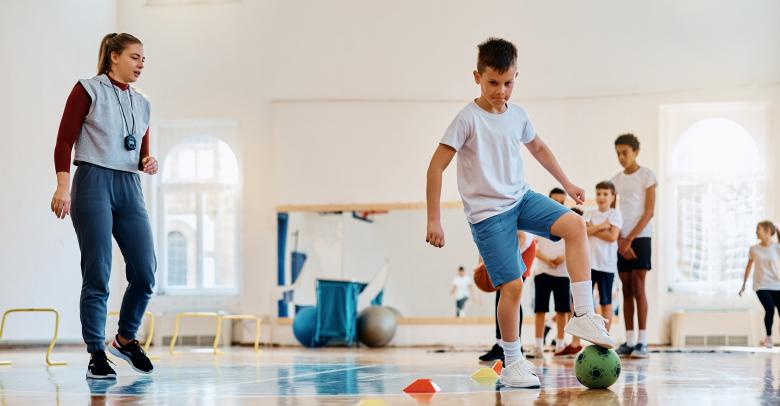The CDC recommends that kids take 11,500 or more steps and/or have at least 60 minutes of physical activity per day. If we were to rely on this happening in school, sadly, most kids would be out of luck. Only the very fortunate students receive daily PE. Research shows that despite the plethora of benefits of daily physical education and physical activity, only 8% of elementary schools, 6.4% of middle schools, and 5.8% of high schools provide PE to all of its students every day. Worse yet, about 20% of elementary schools have even ditched recess in an effort to improve test scores. All this results in a dearth of physical activity for school kids in the US
What can you do? When you teach physical education or lead physical activity sessions, use the following strategies to help you be more efficient so your students spend less time standing around and more time engaged in moderate-to-vigorous physical activity (MVPA). These active minutes add up and help you get more bang for your PE buck.
Instructional Strategies (those that help with giving instructions)
• Insist on students’ attention when giving instructions. Whatever your method (count down from 5, all gather in, etc.), be sure students have eyes and ears ready for learning when you are teaching. Balls or other implements should be placed on the ground so they are not distracting, and students should be facing you. If outside, be sure they are not facing the sun or other distractions. Be consistent with this throughout the year and you will save yourself a lot of repetition and time!
• Once you have their attention, allow them to travel the perimeter while listening to help increase MVPA.
• Keep instructions brief. No need for extra verbiage. Every extra word is time taken away from their practice.
• When introducing an activity, use “The object is… You do that by…” This gives students the overall object of the game, followed by the basic rules in order of play and importance.
• Use the 80/20 Rule: Most (about 80%) of your students will catch on by listening to your instructions. The rest (20%) may not be auditory learners and they will get it once they begin to see others move and play. Don’t ask if they have any questions, as it will slow things down. Once they all begin to play, as you watch and move around the class, find students who aren’t getting it and give them more instruction, or do a demonstration with their group, to help them on their way.
• For some activities, a “show and tell” (demonstration) works the best. As you explain the drill or game, have a centrally located group act it out. Be sure if they do something incorrectly, to correct it and make sure the class knows how it should be done. Obviously, this is not to berate the demonstrators, but to ensure folks know the correct way!
• Say the “when” before the “what”. E.g. “When I say ‘go’ how quickly can you find a partner you will work well with?” or “On the music, begin travelling around the perimeter clockwise.” If you don’t, many of your students begin moving before you are finished with instructions and, while their MVPA goes up, they miss what you want them to do so you end up spending more time repeating it to individuals or small groups.
Management Strategies (those that help with managing students or equipment)
• Transitions are traditionally a big time-suck. While you are getting students into pairs or groups, or getting equipment, or moving to a new activity, MVPA typically goes down. But, when you keep MVPA a priority, you can make transitions smooth and quick.
- Use pre-made partners (call them Workout Buddies) that you use for an entire unit. Whenever you say “Find your XX Buddy (e.g. Thumb Wrestling, Imaginary Rope Jumping, Stretching, etc.) they find that specific partner and do that activity immediately. As soon as you see all pairs together and active, use your signal and begin instruction for the next activity or skill.
- For getting equipment, have students choose who in their group will be the Equipment Manager (EM), or assign EMs for a unit, and they quickly distribute and collect equipment while all are listening to instructions.
- When transitioning from one activity to another, have students move around the perimeter or inside the activity area while you set up for the next activity. Or better yet, show them how to set up their area with cones, spots etc. and have them do it themselves.
• Keep your groups small so students have plenty of opportunities to practice skills. Student to Equipment ratios should be no greater than 10-1 and many times will be 1-1 for individual practice of shooting or ball-handling, or 2-1 for partner activities and passing and receiving drills. Small group games should also have fewer rules than the “real” game so there is less time working out the rules and more time practicing.
• When planning your lessons think about group sizes and how they will change throughout the lesson. Keep them similar for smoother transitions. An example of this is to start with an individual activity such as a ball-handling drill where each student has a ball. Transition into a passing activity by finding pre-made partners and the Equipment Manager taking 1 ball back to the cart. They continue to pass until the signal. Then, pairs join together to form a group of 4 to play a mini-game or do another drill. Again, Equipment Managers handle moving equipment to a safe area.
These strategies will help make your class more efficient and increase MVPA for the benefit of all. Just think, an extra 5 minutes of MVPA during a 30-minute daily PE class adds up to an extra 25 minutes per week, 100 minutes per month, and 1,000 minutes in a school year. That’s an extra 33 whole lessons. Just think what you could teach with all that extra time!






Leave a Reply